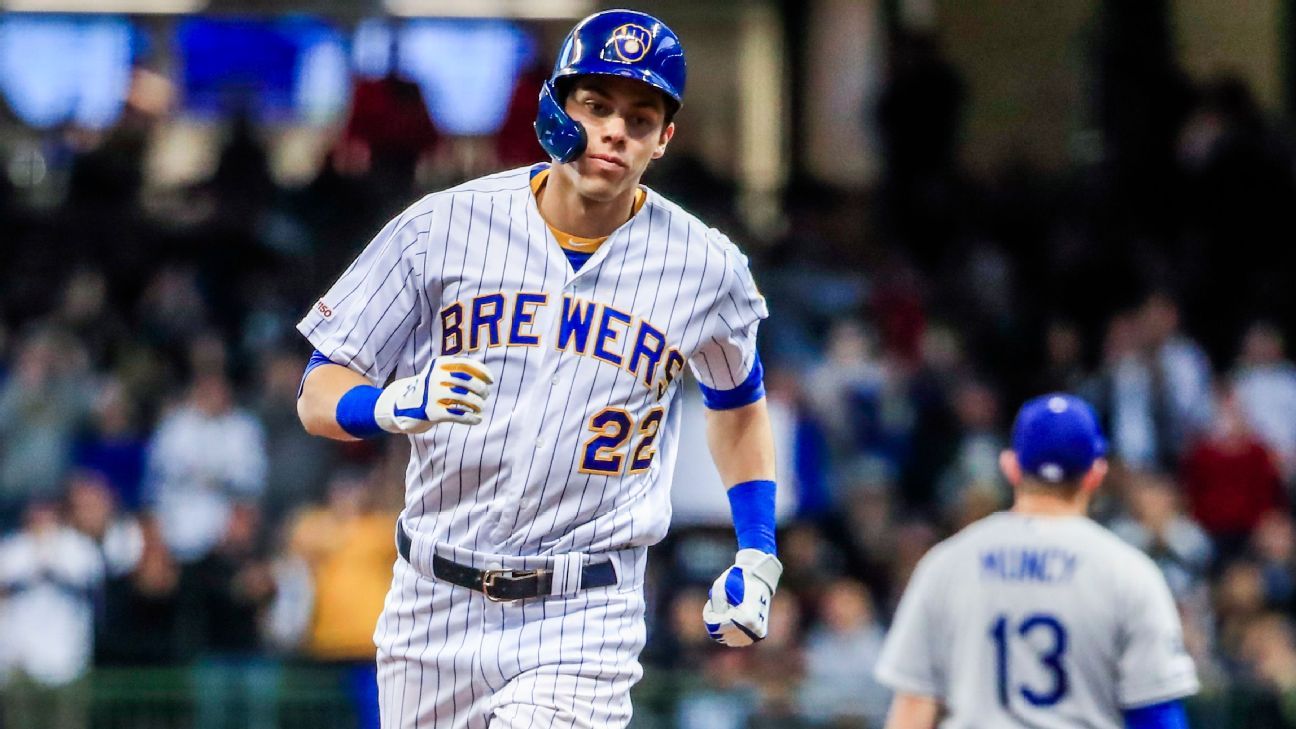Six years ago, when Christian Yelich was just a prospect looking forward to a long career as a Miami Marlin, an interviewer asked him a question:
MiLB.com: Do you consider yourself a five-tool player?
Yelich: That word’s thrown around a lot. Everyone likes to categorize people as five-tool players, four-tool players or whatever. I just like to try and be a complete player and go out every night and give my team a chance to win. Whether you steal a bag, get on base or whatever, I think by the time a 140-game season is over, you look up my numbers and they are what they are.
In the past few weeks, as Yelich has established himself as one of the five best players in the game, he has been referred to as a five-tool player on at least a couple of MLB game broadcasts. Last September, the league’s digital media arm put together a sizzle reel for the 2018 MVP under the heading “Yelich shows off all 5 tools.”
Yelich is right: The phrase “five-tool player” is thrown around a lot, with fair reason, since this is arguably a golden age of five-tool stars. A pleasant side effect of MLB’s Great Youthening — 23 is the new 27 — is that the stars of the game today tend to have “young” skill sets. They can run fast, and they can throw hard — two skills that deteriorate quickly with age. The superstars of this era aren’t 30-year-old mashers with thick thighs and first-basemen’s gloves, but rather shortstops and center fielders and Gold Glove winners who steal bases and hit triples and dive and leap. They’re highlight machines. Yelich, certainly, is a highlight machine.
But he’s probably not actually a five-tool player. Traditionally, a five-tool player is meant to be average or better at hitting for average, hitting for power, running fast, catching baseballs and throwing hard. Yelich is absolutely elite at the first two, way above average in the third, probably good enough in the fourth. But his arm is below average. His “max effort” throw is about 85 mph, according to Statcast data. The typical outfielder’s max-effort throws are around 90 mph. And his fastest throw, which wasn’t very fast by fast-throw standards, came almost four years ago, so it’s probably getting a little worse.
Does this change your opinion of Christian Yelich at all? It shouldn’t. He’s one of the five best players in baseball! But it should make you consider what we mean when we say “five tools,” and how much of what we mean is based on misunderstanding it all.
1. The five tools — originally called the five talents — are primarily about scouting non-major leaguers.
In “Dollar Sign on the Muscle,” the classic book about baseball scouting, author Kevin Kerrane describes the context of the five talents: “The business of baseball scouts is to describe the future, and the future is generally four years away. Consequently, their vocabulary emphasizes energies rather than static quantities.”
Tools are very explicitly not about performance. They were about the innate abilities of the body being scouted. Branch Rickey — often credited as the originator of “the five talents” — thought that “power is inborn, and its control and explosive use is instinctive.” An “arm” grade refers mostly to arm strength, not accuracy, because strength is innate while accuracy can be taught. “Speed,” as a tool, means actual speed, not baserunning acumen, and a hit grade usually focuses on the physical attributes that are conducive to a high batting average, such as swing mechanics, plate coverage and pitch recognition. That’s because scouts aren’t concerned about what a player’s batting average in college or High-A is, but what tools he has that can be developed for four years later. They’re looking for the energy.
2. The concept of well-roundedness is, furthermore, much more valuable for prospects than it is for major leaguers.
For a prospect, the future is broad and unknowable: Some tools will develop, some will stagnate, some will regress, some will be lost to physical change or against more difficult competition. The more tools a player has, the more paths to success he has, the more he can fall back on. A shortstop who shows five tools as a prospect could become a five-tool shortstop in the best case, but in less perfect cases, he could settle in as a defense-only shortstop or a power-hitting third baseman or as a superutility man who hits .275 or, heck, a relief pitcher. In this sense, well-roundedness is almost the metaskill that most predicts success; it’s kind of a sixth tool.
For a major leaguer, well-roundedness is a false god. One- or two-tool players can have long careers, especially when those one or two tools are hitting and power. (Miguel Cabrera was a two-time two-tool MVP.) For the most part, we use WAR as the best guide to player value, and WAR gives no extra points for well-roundedness.
No, in the majors, performance is all that matters. In 2011, when Ben Lindbergh used statistical performance to identify five-tool players in the majors, his search yielded (among others) Ryan Ludwick, a 32-year-old corner outfielder who, at that point, had seven career triples and 16 career steals, in 32 attempts. Ludwick was not remotely fast, not remotely. But he had been a good, smart baserunner in his career (at least according to the metrics Lindbergh was using), which arguably made his tools irrelevant. Lindbergh’s method turned up five-stat players, more than five-tool players, but in the majors, it’s the former that actually makes money.
3. The five tools are not all-encompassing.
There is, for instance, the glaring omission of plate discipline, the ability and willingness to draw a walk, which is no small part of the game. Joey Gallo has almost as many walks this season as he has hits — his ability to walk is arguably more important than his inability to hit singles — but there’s no sixth tool to credit it. One doesn’t need to walk a lot to be a great player any more than one needs to hit for power, or be fast, but a player with all five tools who walks a lot is obviously more well-rounded than one who has all five tools but doesn’t.
Again, though, it’s only a misunderstanding of scouting jargon that treats these five tools as the whole package. For decades, scouting reports have (a) had more than five fields and (b) been expanding. A 1951 report had seven fields — the main five, plus “hustle” and “habits.” A 1968 report’s seven fields (the five, plus baserunning and “miscellaneous,” which referred to grit-type attributes) each have four different subfields, establishing 28 distinct skills. And when they scouted Bo Jackson in the 1980s, there were 10 fields — not subcategories, but 10 distinct skills.
So while it makes sense for scouts to think of the five physical “tools” underlying physical projection, it’s a fallacy to import that language to the majors and conclude those are the only five ways a baseball player contributes. Nor even the five most important ways.
Yelich is pretty close to a perfect ballplayer. So are Alex Bregman, Francisco Lindor and Cody Bellinger. Mookie Betts is probably even closer to perfect, and Mike Trout, though faintly imperfect, is most perfect-like of all. Given five lines on a sheet of paper, what would you use to capture the broadness of Trout’s (and Lindor’s) greatness?
Consider this a personal swing at the question, not definitive, but:
-
The ability to hit the ball over outfielders, best expressed in long extra-base hits and home runs.
-
The ability to play a position of value, which encompasses both a strong-enough arm and good-enough speed or agility.
-
The ability to control the strike zone, most often (but not always) expressed by a combination of low swing rates on pitches out of the zone and somewhat higher swing rates on pitches in the zone.
-
The ability to make solid contact, expressed in consistently high exit velocities and more line drives/productive fly balls than grounders and pop-ups.
-
The ability to pressure defenses with speed, either as a baserunner or as a batter.
Pretty close to the same list as scouting’s five talents! But these five are all framed around performance, rather than tools. They’re a bit closer to equal value, so that we don’t go through the silly charade of treating a major leaguer’s arm strength as being on the same level as his ability to hit for power. And they reflect a more modern understanding of how baseball is played, how performance is valued and what we can measure at the major league level.
Ultimately, though, maybe it’s not important to improve on the “five-tool” conversation. When we say Christian Yelich is a five-tool player, it has a literal meaning. But it also has an idiomatic meaning — he’s a superstar in the style of Mickey Mantle rather than of Mark McGwire — and it’s not uncommon for idioms to gradually lose connection with their original, literal meanings. There’s a good chance we’ll be calling guys five-tool players long after scouts have quit using the five tools at all. Fair enough: Christian Yelich is great. He is a complete player, and he goes out every night and he gives his team a chance to win.

